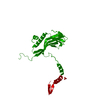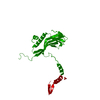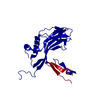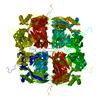+ Open data
Open data
- Basic information
Basic information
| Entry | Database: PDB / ID: 3jw6 | ||||||
|---|---|---|---|---|---|---|---|
| Title | Crystal structure of AcMNPV baculovirus polyhedra | ||||||
 Components Components | Polyhedrin | ||||||
 Keywords Keywords | VIRAL PROTEIN / Jelly-roll / disulfide bond / domain swapping / Viral occlusion body | ||||||
| Function / homology | Polyhedrin / Polyhedrin / viral occlusion body / host cell nuclear matrix / structural molecule activity / identical protein binding / Polyhedrin Function and homology information Function and homology information | ||||||
| Biological species |  Autographa californica nuclear polyhedrosis virus Autographa californica nuclear polyhedrosis virus | ||||||
| Method |  X-RAY DIFFRACTION / X-RAY DIFFRACTION /  SYNCHROTRON / SYNCHROTRON /  MIR / Resolution: 2.3 Å MIR / Resolution: 2.3 Å | ||||||
 Authors Authors | Coulibaly, F. / Chiu, E. / Metcalf, P. | ||||||
 Citation Citation |  Journal: Proc.Natl.Acad.Sci.USA / Year: 2009 Journal: Proc.Natl.Acad.Sci.USA / Year: 2009Title: The atomic structure of baculovirus polyhedra reveals the independent emergence of infectious crystals in DNA and RNA viruses Authors: Coulibaly, F. / Chiu, E. / Gutmann, S. / Rajendran, C. / Haebel, P.W. / Ikeda, K. / Mori, H. / Ward, V.K. / Schulze-Briese, C. / Metcalf, P. | ||||||
| History |
|
- Structure visualization
Structure visualization
| Structure viewer | Molecule:  Molmil Molmil Jmol/JSmol Jmol/JSmol |
|---|
- Downloads & links
Downloads & links
- Download
Download
| PDBx/mmCIF format |  3jw6.cif.gz 3jw6.cif.gz | 56.2 KB | Display |  PDBx/mmCIF format PDBx/mmCIF format |
|---|---|---|---|---|
| PDB format |  pdb3jw6.ent.gz pdb3jw6.ent.gz | 40.3 KB | Display |  PDB format PDB format |
| PDBx/mmJSON format |  3jw6.json.gz 3jw6.json.gz | Tree view |  PDBx/mmJSON format PDBx/mmJSON format | |
| Others |  Other downloads Other downloads |
-Validation report
| Summary document |  3jw6_validation.pdf.gz 3jw6_validation.pdf.gz | 434.4 KB | Display |  wwPDB validaton report wwPDB validaton report |
|---|---|---|---|---|
| Full document |  3jw6_full_validation.pdf.gz 3jw6_full_validation.pdf.gz | 434.4 KB | Display | |
| Data in XML |  3jw6_validation.xml.gz 3jw6_validation.xml.gz | 10.9 KB | Display | |
| Data in CIF |  3jw6_validation.cif.gz 3jw6_validation.cif.gz | 13.7 KB | Display | |
| Arichive directory |  https://data.pdbj.org/pub/pdb/validation_reports/jw/3jw6 https://data.pdbj.org/pub/pdb/validation_reports/jw/3jw6 ftp://data.pdbj.org/pub/pdb/validation_reports/jw/3jw6 ftp://data.pdbj.org/pub/pdb/validation_reports/jw/3jw6 | HTTPS FTP |
-Related structure data
- Links
Links
- Assembly
Assembly
| Deposited unit | 
| |||||||||
|---|---|---|---|---|---|---|---|---|---|---|
| 1 | x 12
| |||||||||
| Unit cell |
| |||||||||
| Components on special symmetry positions |
| |||||||||
| Details | POLYHEDRA ARE VIRUS-CONTAINING CRYSTALS, WHICH REPRESENT THE MAIN INFECTIOUS FORM OF BACULOVIRUS. THE BIOLOGICAL ASSEMBLY IS THE WHOLE CRYSTAL. DODECAMERS OF THE POLYHEDRIN PROTEIN ARE PUTATIVE BUILDING BLOCKS OF THE CRYSTAL, WHICH ARE GENERATED BY THE SYMMETRY OPERATIONS. |
- Components
Components
| #1: Protein | Mass: 29018.131 Da / Num. of mol.: 1 / Mutation: G25D Source method: isolated from a genetically manipulated source Source: (gene. exp.)  Autographa californica nuclear polyhedrosis virus Autographa californica nuclear polyhedrosis virusDescription: Crystals were purified from Sf21 cells infected by the Autographa californica Multicapsid Nucleopolyhedrovirus (AcMNPV) Cell: Sf21 / Gene: PH, P29, POLH / Cell line (production host): sf9 / Production host:  |
|---|---|
| #2: Chemical | ChemComp-EDO / |
| #3: Water | ChemComp-HOH / |
| Has protein modification | Y |
-Experimental details
-Experiment
| Experiment | Method:  X-RAY DIFFRACTION / Number of used crystals: 5 X-RAY DIFFRACTION / Number of used crystals: 5 |
|---|
- Sample preparation
Sample preparation
| Crystal | Density Matthews: 1.579947 Å3/Da / Density % sol: 22.149273 % / Mosaicity: 0.477 ° |
|---|---|
| Crystal grow | Temperature: 300 K / pH: 7 Details: Natural intracellular crystals were directly purified from Sf21 cells infected by the AcMNPV baculovirus, pH 7, temperature 300K |
-Data collection
| Diffraction | Mean temperature: 100 K |
|---|---|
| Diffraction source | Source:  SYNCHROTRON / Site: SYNCHROTRON / Site:  SLS SLS  / Beamline: X06SA / Wavelength: 0.9789 Å / Beamline: X06SA / Wavelength: 0.9789 Å |
| Detector | Type: MAR CCD 165 mm / Detector: CCD / Date: Feb 17, 2007 / Details: MD2 microdiffractometer |
| Radiation | Monochromator: SAGITALLY HORIZONTAL FOCUSSING SI(111) MERIDIONALLY VERTICAL FOCUSSING RH-COATED MIRROR Protocol: SINGLE WAVELENGTH / Monochromatic (M) / Laue (L): M / Scattering type: x-ray |
| Radiation wavelength | Wavelength: 0.9789 Å / Relative weight: 1 |
| Reflection | Resolution: 2.3→20 Å / Num. all: 8281 / Num. obs: 8256 / % possible obs: 99.7 % / Observed criterion σ(F): -3 / Observed criterion σ(I): -3 / Redundancy: 6.6 % / Biso Wilson estimate: 31.1 Å2 / Rmerge(I) obs: 0.149 / Χ2: 0.998 / Net I/σ(I): 6.2 |
| Reflection shell | Resolution: 2.3→2.38 Å / Redundancy: 6.3 % / Rmerge(I) obs: 0.55 / Mean I/σ(I) obs: 3.8 / Num. unique all: 800 / Χ2: 0.963 / % possible all: 99.1 |
-Phasing
| Phasing | Method:  MIR MIR |
|---|
- Processing
Processing
| Software |
| ||||||||||||||||||||||||||||
|---|---|---|---|---|---|---|---|---|---|---|---|---|---|---|---|---|---|---|---|---|---|---|---|---|---|---|---|---|---|
| Refinement | Method to determine structure:  MIR / Resolution: 2.3→18.84 Å / Cor.coef. Fo:Fc: 0.947 / Cor.coef. Fo:Fc free: 0.918 / Occupancy max: 1 / Occupancy min: 0.5 / Isotropic thermal model: Isotropic / Cross valid method: THROUGHOUT / σ(F): 0 / Stereochemistry target values: Engh & Huber MIR / Resolution: 2.3→18.84 Å / Cor.coef. Fo:Fc: 0.947 / Cor.coef. Fo:Fc free: 0.918 / Occupancy max: 1 / Occupancy min: 0.5 / Isotropic thermal model: Isotropic / Cross valid method: THROUGHOUT / σ(F): 0 / Stereochemistry target values: Engh & HuberDetails: Residue ACys132 forms a disulfide bond with residue BCys132 of symmetry molecule 4566. By symmetry, this also implies that residue BCys132 forms a disulfide bond with residue ACys132 of symmetry molecule 4566.
| ||||||||||||||||||||||||||||
| Displacement parameters | Biso max: 87.92 Å2 / Biso mean: 24.422 Å2 / Biso min: 7.2 Å2
| ||||||||||||||||||||||||||||
| Refine analyze | Luzzati coordinate error obs: 0.199 Å | ||||||||||||||||||||||||||||
| Refinement step | Cycle: LAST / Resolution: 2.3→18.84 Å
| ||||||||||||||||||||||||||||
| Refine LS restraints |
| ||||||||||||||||||||||||||||
| LS refinement shell | Resolution: 2.3→2.57 Å / Total num. of bins used: 5
|
 Movie
Movie Controller
Controller









 PDBj
PDBj


